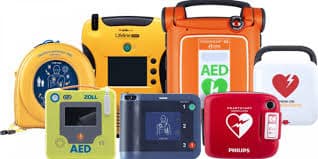Uncategorized
Refurbished AED vs New AED: Evidence-Based Cost and Survival Rates
Automated External Defibrillators (AEDs) have transformed emergency response to sudden cardiac arrest (SCA) in public spaces, workplaces, and healthcare settings. While the life-saving importance of AEDs is undisputed, organizations and individuals often face a crucial purchasing decision: should they invest in new AEDs or opt for refurbished units? This decision carries both financial and clinical implications. According to data published by the Sudden Cardiac Arrest Foundation, survival rates from out-of-hospital cardiac arrest can increase from under 10% to over 45% when AEDs are used promptly before emergency services arrive. This underscores the value of ensuring AED availability, regardless of whether the device is new or refurbished.
Difference Between Refurbished and New AEDs
A new AED comes directly from the manufacturer, offering the latest technology, full warranties, and the longest device lifespan. These units often include cutting-edge features such as real-time CPR feedback, wireless connectivity, and extended battery duration.
A refurbished AED, by contrast, is a previously owned device that has been carefully inspected, tested, and restored to meet manufacturer or industry standards. Refurbished AEDs typically come with replacement batteries and pads, updated software, and a limited warranty. They are often sold by certified resellers or directly by manufacturers’ refurbishment programs. While they may lack the very latest features, their core function, analyzing heart rhythms and delivering shocks, is identical to that of new AEDs when properly maintained.

Cost Comparison and Budgetary Considerations
Cost is a major factor influencing the decision between new and refurbished AEDs. New devices can cost anywhere from several hundred to several thousand dollars, depending on the model and features. Refurbished AEDs, however, are often available at 40–60% lower prices than their new counterparts. This price difference can make AED acquisition more accessible for small businesses, schools, community centers, and nonprofits.
Organizations purchasing multiple devices, such as airports, gyms, or school districts, can significantly expand their AED coverage by choosing refurbished units without exceeding their budgets. In settings where coverage gaps are a concern, more AEDs in more locations can directly translate into higher chances of timely defibrillation.
Regulatory and Quality Standards for Refurbished AEDs
Refurbished AEDs must meet strict testing and certification protocols before resale. Reputable refurbishers conduct multi-point inspections, replace critical components like batteries and pads, and perform performance tests to ensure reliability. Additionally, many regulatory bodies require that AEDs, whether new or refurbished, comply with the same operational standards.
Organizations purchasing refurbished AEDs should ensure that the devices come from authorized dealers who provide documentation of testing and offer warranties. A well-refurbished AED is not a “second-rate” option but a medically sound, cost-effective alternative.
Evidence-Based Survival Rates and Device Performance
The effectiveness of AEDs in saving lives depends far more on timely access and proper use than on whether the unit is new or refurbished. Data indicate that early defibrillation can raise survival rates from less than 10% to more than 45%, regardless of the device’s age or whether it’s new or refurbished, provided it is properly maintained and functional.
Survival rates are driven by response time, CPR quality, and defibrillation speed, not by whether the AED was purchased new. In real-world deployments, refurbished AEDs have demonstrated reliability comparable to new devices when sourced through accredited refurbishment programs.
Maintenance Requirements for Long-Term Reliability
Both new and refurbished AEDs require regular maintenance to ensure readiness in an emergency. Maintenance typically involves:
Battery Checks:
Ensuring the device has sufficient charge and replacing batteries when they near expiration.
Pad Replacement:
Defibrillation pads have expiration dates and must be replaced regularly to maintain proper adhesion and conductivity.
Software Updates:
Some AEDs require periodic software updates to remain compliant with current resuscitation guidelines.
Visual Inspections:
Checking the device’s indicator lights or status displays to confirm operational readiness.
When organizations commit to proper maintenance, refurbished AEDs can deliver performance equivalent to new units over their operational lifespan.
Warranty and Support Considerations
Warranty length and service support often differ between new and refurbished AEDs. New devices typically come with longer manufacturer warranties, sometimes extending up to eight years, along with comprehensive customer support. Refurbished units may offer shorter warranties, often between one and three years, depending on the supplier.
However, many refurbishment programs now include service plans and extended warranty options, narrowing the gap between the two. Organizations must weigh whether the potential cost savings of refurbished units offset the shorter warranty period, especially in resource-limited environments.
Technological Features vs Core Functionality
While some refurbished AEDs may lack the newest technological features, these features are often enhancements rather than essential functions. For example, Wi-Fi connectivity, bilingual voice prompts, or advanced CPR feedback can improve the user experience, but the fundamental ability to analyze and deliver a shock remains the same.
For high-traffic environments where rapid response is paramount, basic AED functionality is often sufficient. Organizations that require advanced data tracking or integration with centralized emergency systems may benefit more from newer models with modern communication capabilities.
Strategic Deployment and Coverage
One of the most powerful arguments for refurbished AEDs is strategic coverage. Instead of purchasing fewer high-cost new devices, many organizations can deploy a larger number of refurbished AEDs, thereby covering more physical areas. This can dramatically shorten response times, which is the single most important factor in survival.
For example, a large facility may place refurbished AEDs in multiple corridors or buildings rather than relying on a single unit located in a central area. Increased accessibility ensures that defibrillation can occur within the critical first few minutes of cardiac arrest, maximizing survival odds.
Environmental and Sustainability Benefits
Choosing refurbished AEDs can also align with sustainability goals. Extending the lifecycle of existing medical equipment reduces electronic waste and minimizes the environmental footprint associated with manufacturing new devices. Organizations with green procurement policies may view refurbished AEDs as both a fiscally and environmentally responsible choice.
Conclusion: Balancing Cost, Performance, and Access
The debate between refurbished and new AEDs ultimately comes down to balancing cost, performance, and accessibility. New AEDs offer the longest warranties, the latest features, and manufacturer support, making them ideal for organizations with sufficient budgets and complex operational needs. Refurbished AEDs, on the other hand, provide a cost-effective, reliable, and medically sound alternative, especially valuable for expanding AED coverage in budget-constrained settings.
Crucially, the life-saving effectiveness of AEDs is not determined by whether they are new or refurbished, but by whether they are accessible, well-maintained, and used quickly during cardiac arrest. The evidence is clear: early defibrillation saves lives, and both new and refurbished AEDs play a vital role in making that possible.






